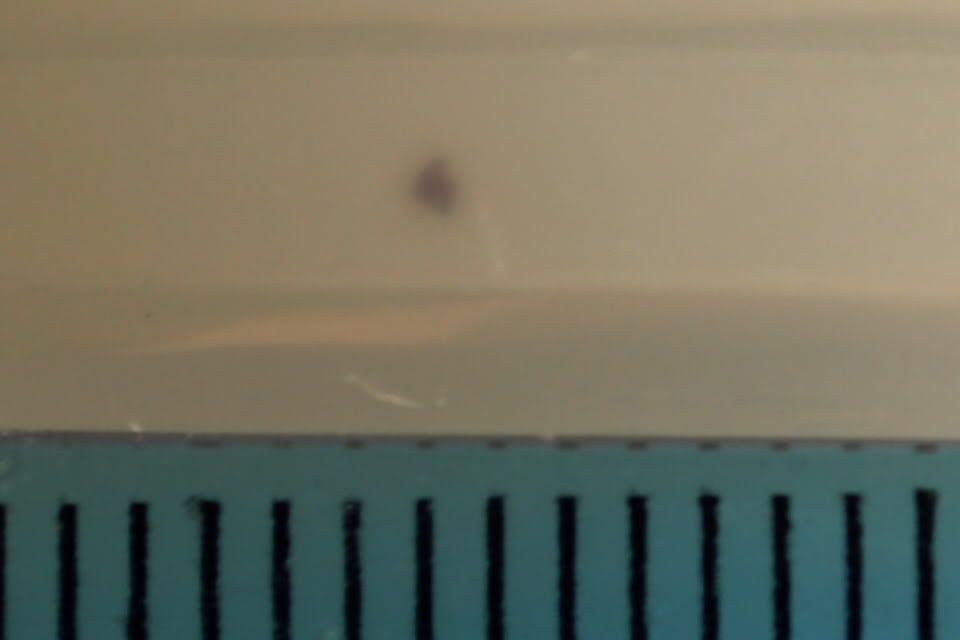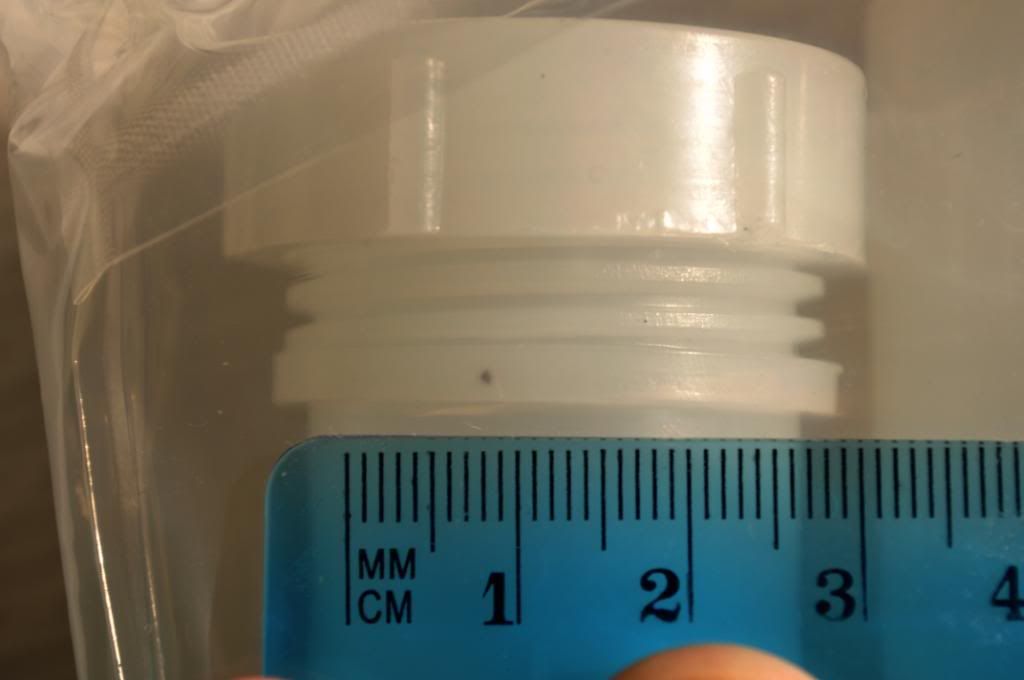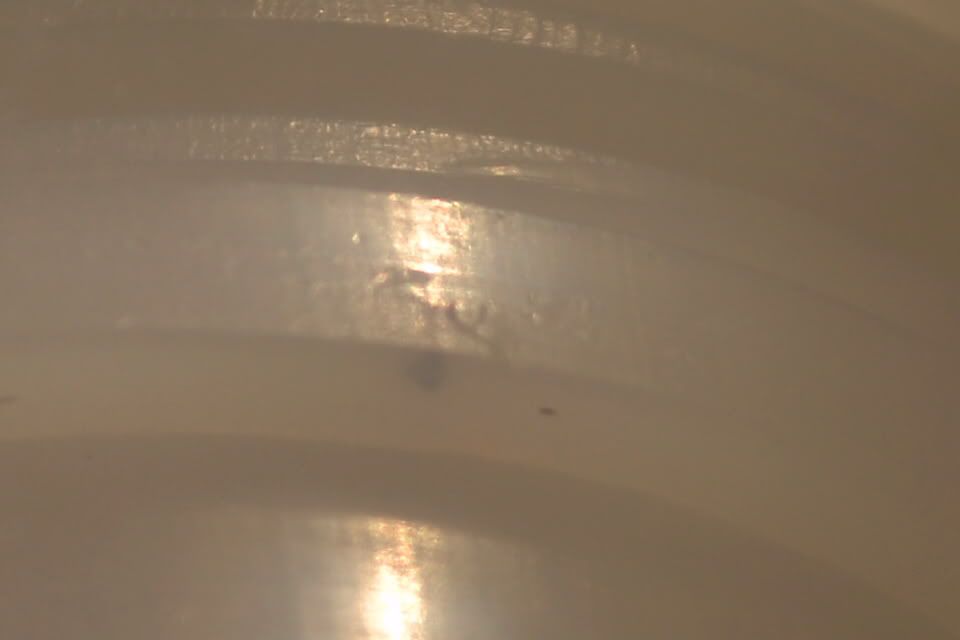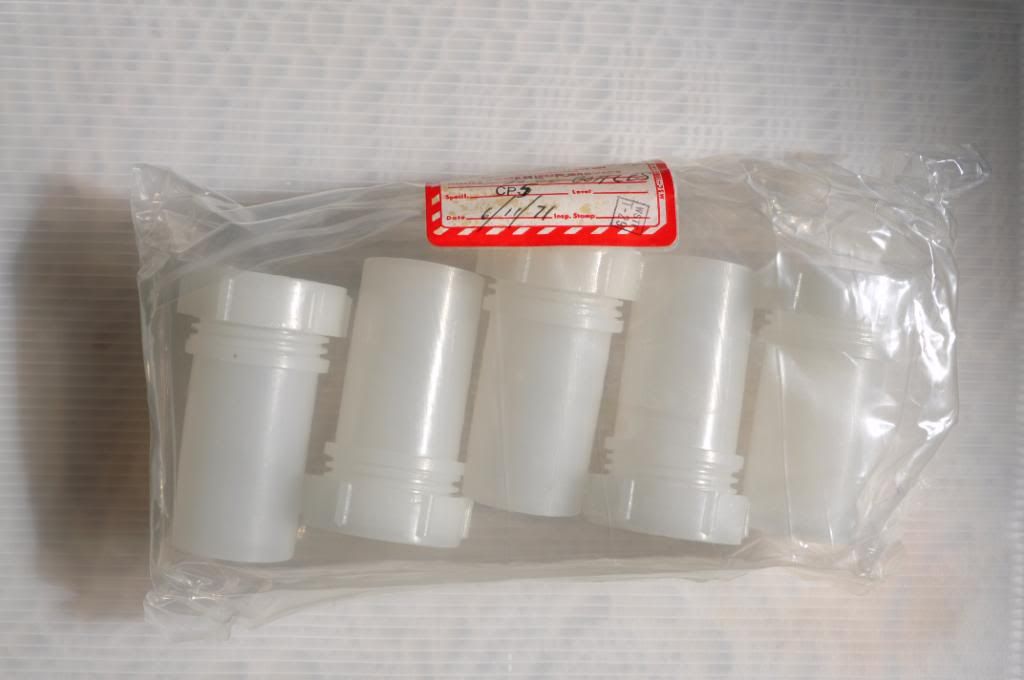|
|

|
|
Author
|
Topic: Inclusion stuck in lunar secondary sample bottle
|
AusSpace
Member Posts: 25
From: Adelaide, South Australia, Australia
Registered: Nov 2010
|
 posted 04-22-2011 09:03 AM
posted 04-22-2011 09:03 AM
   
A little over a month ago I purchased a packet of five Lunar Secondary Sample Bottles. Recently when I went to take some photos of them I noticed that one of them has a small inclusion imbedded in it. At first I thought it might just be sticking to the surface, but under magnification it's clear it's imbedded. At the right angle you can clearly see the entry hole where I assume the inclusion has penetrated the plastic. It is almost a millimeter in size, so clearly visible to the unaided eye even from arms length. The bottles are wrapped in two layers of plastic. The first outer layer is thin and brittle with a small hole in the side, but the inner layer is a much thicker, heat sealed plastic that is completely intact without any holes, so the object was obviously in there before it was sealed. The question I've been wondering is; could this be a small grain of regolith or rock that penetrated the plastic while being collected in the container, then remained there during the cleaning and sterilization because it was imbedded deep enough. If there is a chance that it could be a lunar grain, would there be any way possible to remove it for display without destroying the provenance? I've thought that given it's size, I could take it to the local microscopy lab and have it imaged, then have the grain set in a frame below the image or images. I'd really appreciate any thought on this matter what so ever. Inclusion with a millimeter scale:  
Perforated entry point:  Whole packet. Inclusion can be seen in bottle on the left:  |
SpaceAholic
Member Posts: 4437
From: Sierra Vista, Arizona
Registered: Nov 1999
|
 posted 04-22-2011 10:17 AM
posted 04-22-2011 10:17 AM
   
Does the entry path originate from the interior or exterior of the bottle? Will inspect a similar pack I have to assist with determining if your observation is atypical. There are other possibilities (manufacturing defect, or the inclusion could be from some other source such as introduction during the sterilization process which applies heat and would make the plastic more malleable). If there was a satisfactory way of applying NDE to affirm the object is lunar material, I would prefer to leave it embedded within the bottle to protect its provenance. |
freshspot
unregistered
|
 posted 04-23-2011 02:21 AM
posted 04-23-2011 02:21 AM
 
Interesting find. I have two sets of sample bottles like yours (ten bottles total / unopened packages of five). I checked them and did not see anything similar. Dave Scott (not the astronaut)
www.apolloartifacts.com |
MadSci
Member Posts: 226
From: Maryland, USA
Registered: Oct 2008
|
 posted 04-25-2011 05:54 PM
posted 04-25-2011 05:54 PM
  
Wahoo - I'm going to be checking my sample vials tonight!A couple of thoughts on identifying the 'speck' - much of the work done to identify lunar meteorites, and to examine the Apollo materials, is done non-destructively via spectroscopy. Admittedly, most of the instruments for doing so are designed to work on rocks samples on defined grids, not embedded into plastic - however some spectroscopic instruments can probably be found to get at least a good starting point (eliminating rust as a contender for example). I think you might get some interesting suggestions, and maybe some direct offers of help from either the Lunar Sample Laboratory Facility via their contact person for Sample Requests. Another point to start asking for help might be Randy Korotev at Washington University in St. Louis who has a popular website for identifying lunar meteorites. It's not a meteorite but he might be able to steer you to an academic lab interested and equipped to examine your material. Good luck and keep us posted! |
AusSpace
Member Posts: 25
From: Adelaide, South Australia, Australia
Registered: Nov 2010
|
 posted 04-29-2011 11:34 PM
posted 04-29-2011 11:34 PM
   
Thank you for your most valuable responses, and sorry for the late reply, I've been away and beyond internet access. In answer to your first question Spaceaholic, the entry point is on the outside of the bottle, on the small lip below the lid. I could imagine it would have been possible for a grain to puncture it in that spot if the bottle was used to "scoop up" material, but I don't know whether "scooping" would have been to cumbersome a way to exchange samples? After giving it some thought I've decided that whatever it turns out to be, lunar or other, it would be best to leave it in its historical context, stuck in the bottle. I kind of consider this analogous to possessing a goodwill moon rock. Would you remove it from its plaque and display it some other way, or would you preserve it the way it was intended to be for future generations? Thank you for those suggestions MadSci, I will defiantly be following these up. If for investigation, the bottle would need to be removed from the packet, would it be sufficient provenance to have the lab document every step in writing, even if that involved removing the inclusion for study, then reinserting it? Perhaps then sealing the package with a laboratory seal similar to the NASA seal it already bears? Thank you once again for your insights. | |
Contact Us | The Source for Space History & Artifacts
Copyright 2020 collectSPACE.com All rights reserved.

Ultimate Bulletin Board 5.47a
|
|

|
 advertisement advertisement

|















